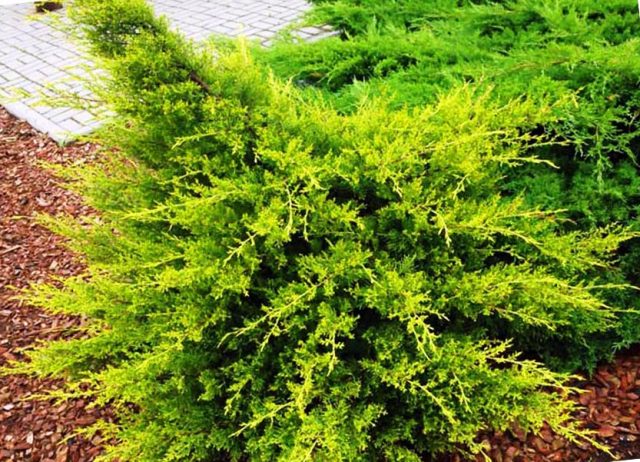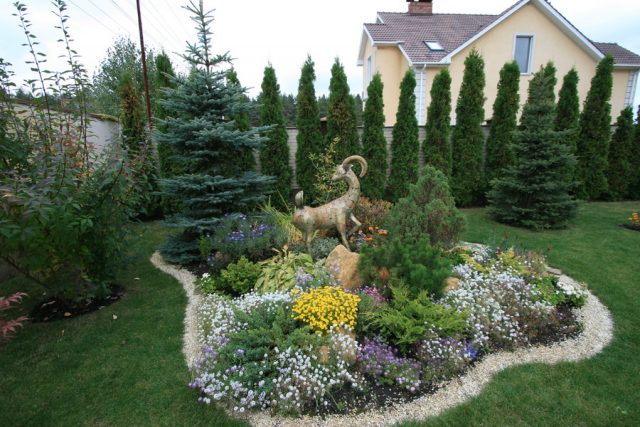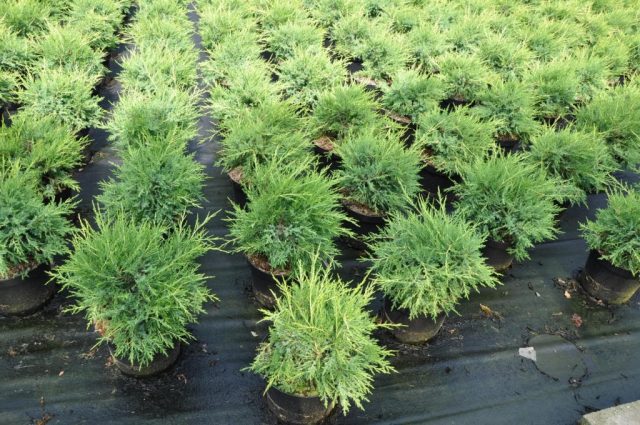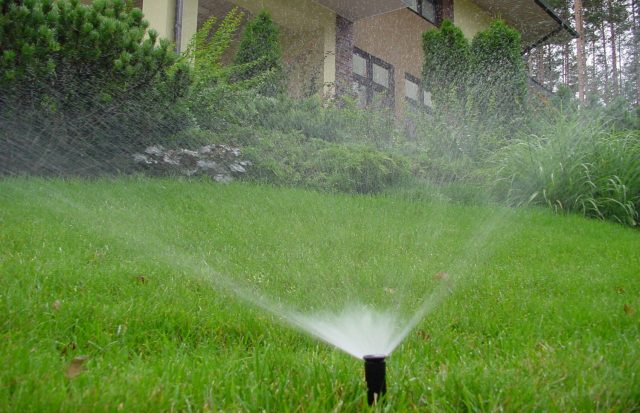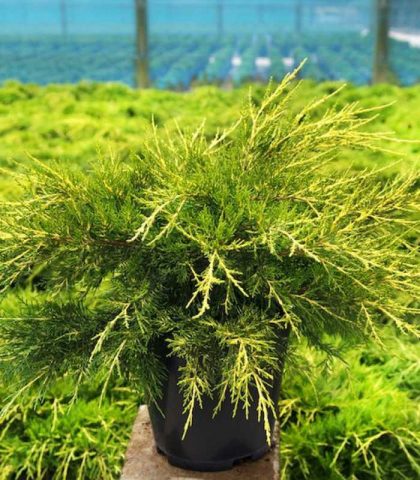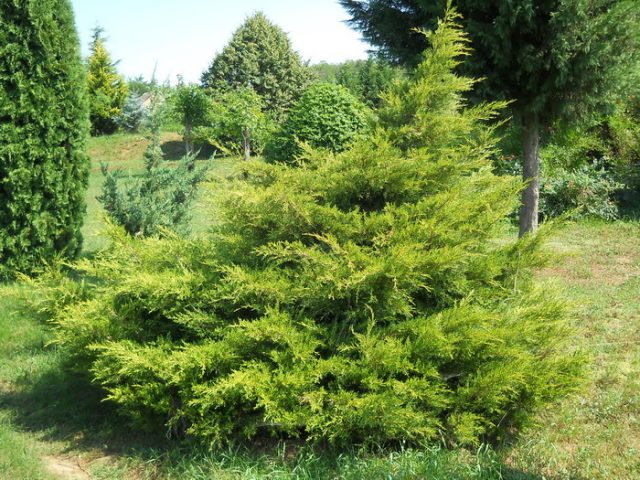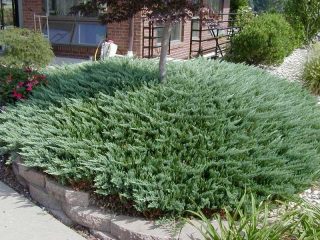Content
Juniper Chinese Kurivao Gold is a coniferous shrub with an asymmetrical crown and golden shoots, which is often used as a decorative element in the design of the local area. Belongs to the Cypress family. It occurs naturally in northeastern China, Korea and southern Manchuria.
Description Juniper Chinese Kuriwao Gold
Juniper Kurivao Gold belongs to vigorous coniferous shrubs. The height of a ten-year-old specimen is within 1.5–2 m, older ones stretch up to 3 m. The branches are spreading, therefore the diameter of the juniper reaches 1.5 m. The shoots are wide and grow upwards.
Young shoots of the juniper of the Chinese Kurivao Gold, shown in the photo, have an interesting golden color, which stands out favorably against the background of green needles scales. There are many small cones on the Kurivao Gold bushes.
The branches tolerate the haircut well, give up to 20 cm of growth annually. Thanks to this, you can bring to life any design idea and cut the bush, giving it the necessary shape.
Loam and sandy loam are suitable for planting. The acidity index of the soil should be minimal. The seedling tolerates drought and urban air pollution well.
Juniper Kurivao Gold in garden design
Chinese juniper is often used in garden or house design. An interesting ephedra in a group planting with other evergreen seedlings. Single planting of Kurivao Gold juniper is possible.
The bush will fit well in a rocky garden and rockery. Junipers are used to decorate terraces and entrances. Kurivao Gold combines favorably with perennial herbaceous plants. This variety of Chinese juniper is recommended for making bonsai. With its help, hedges are created.
Planting and caring for Kurivao Gold juniper
In order for a seedling to please the eye for many years and be a real highlight of the landscape, it is necessary to take into account some requirements regarding planting and caring for a Chinese juniper.
Seedling and planting plot preparation
Chinese juniper tolerates drought well, but does not thrive on heavy, clayey soils. With a close occurrence of groundwater and on clay soils, it is necessary to take care of the drainage system when planting. To do this, a twenty-centimeter layer of expanded clay, gravel or broken brick is laid at the bottom of the landing pit.
Saplings feel good in sunny areas with partial shade. Without shading, the color of Chinese juniper becomes less juicy.
When planting in groups, it should be borne in mind that the diameter of an adult plant reaches 1.5 meters, so the distance between adjacent specimens should be at least 1.5-2 m.
The size of the planting pit depends on the purchased seedling. Having estimated the volume of the earthen coma on the juniper, they dig a hole. Sufficient depth for planting juniper is 0.7 m.
Landing rules
For planting, they dig a hole 2 times larger than the size of the pot in which the seedling is located. It is necessary to ensure that the root collar does not end up underground during planting. It should be located slightly above the ground.
The pit is filled with a mixture of compost, peat and black soil, taken in equal parts. A complex mineral fertilizer is added. Saplings purchased from the nursery most often already have a supply of fertilizers necessary for full growth. In this case, fertilizer should not be added to the planting pit. Such a seedling should be fed the next year after planting.
The seedling is installed vertically, covered with soil mixture, the earth is tamped so that a funnel is formed around the juniper. It is necessary to ensure that they do not grow near a seedling with a diameter of 70 cm weeds or lawn grass. The trunk circle should be free so that the roots of the juniper receive the necessary nutrients and oxygen. To improve air exchange, the soil in the hole is periodically loosened.
Watering and feeding
Young juniper needs watering. Depending on the weather conditions, 1 to 3 buckets are poured into the hole weekly. In severe drought, the amount of water is increased, preventing drying out and cracking of the soil.
Adult shrubs are watered no more than 2-3 times per season. On hot days, sprinkling can be carried out, the procedure is postponed until the evening hours, since after sunset the risk of burning the wet crown is minimal.
Fertilize the land once a year. The event is held in the spring in April-May. Complex formulations are used as fertilizers, for example, Kemira-wagon. Adult juniper bushes do not need feeding, organic matter is enough.
Mulching and loosening
In spring and autumn, the hole is mulched with compost to improve the structure of the soil and prevent the roots from freezing.
Young Kurivao Gold seedlings need loosening of the soil, which is carried out after watering or rain. The ground around the seedling should not be allowed to turn into a hardened layer, this immediately impairs air exchange and negatively affects the appearance of the juniper.
Loosening should be shallow so as not to damage the root system of the seedling. The procedure allows you to cope with another task - the removal of weeds. During loosening, the grass is removed from the trunk circle together with the roots. The spreading of mulch prevents weeds from growing in the trunk circle.
Trimming and shaping
Chinese juniper Kurivao Gold fell in love with many landscape designers because of its unpretentiousness and the possibility of pruning. The crown can be formed in accordance with any idea. Kurivao Gold responds well to a haircut, while the crown becomes more luxuriant and more beautiful.
For the first time, pruning is postponed in early spring. In March, when the temperature has risen above +4 ° C, but the active growth of branches has not begun, the first pruning is performed. The second time it is allowed to prune the shoots in August.
Preparing for winter
Young juniper bushes can freeze slightly in winter, so the seedlings need shelter. An adult Chinese juniper can do without shelter, but the layer of mulching material underneath should be increased in the fall.
To hide Kurivao Gold, spruce branches and burlap are used. To protect the branches from heavy snow, a protective structure in the form of a tripod can be installed over the bush. In the fall, the trunk circle is dug up, water-charging irrigation is done and insulated with a layer (at least 10 cm) of mulching material: peat, sawdust.
In the spring, burlap is also used to protect the crown from sunburn.
Reproduction of the Chinese juniper Juniperus Chinensis Kuriwao Gold
There are several breeding methods for Chinese juniper:
- seeds;
- cuttings;
- layering.
The most commonly used method is cuttings. This method allows you to simultaneously obtain the required number of seedlings in a short period of time.Young, but barked shoots with a length of 10 to 20 cm are separated from the mother bush so that part of the trunk with bark remains on them. Works are carried out in February.
The bottom of the shoot is cleaned of needles and placed in a root growth stimulator (Kornevin) for several hours. A mixture of humus, sand and peat in equal parts is poured into the boxes for planting. Cuttings of Kurivao Gold are buried in the ground by 2-3 cm, the boxes are covered with foil and taken out to a lighted place. Water regularly if the air is too dry, additionally use spraying. The film is removed after rooting. Seedlings of Chinese juniper are planted in open ground for the next year.
Planting by layering is as follows:
- the soil is loosened around the adult juniper;
- additionally, humus, peat and sand are introduced into the soil;
- the side branch is cleaned of needles and bark in several places and bends it to the ground;
- the bent branch is fixed with metal pins and sprinkled with earth;
- watered regularly;
- the next year, they are separated from the mother bush;
- transplanted to a permanent place when new shoots appear.
Seed propagation is a long and troublesome process, so it is rarely used.
Diseases and pests
A danger to young Kurivao Gold seedlings is a fungus caused by excessive moisture in the soil. First, the roots turn black, then the top dries up and the juniper dies. It is very difficult to cope with the fungus, so the plant is dug up and burned. Prevention consists in controlling soil moisture. Waterlogging should not be allowed.
It is not recommended to plant the Chinese Kurivao Gold juniper near apple, pear and hawthorn trees. On these crops there is rust that can transfer to juniper. If traces of rust appear on the ephedra, it is necessary to cut off the affected branches with a sterile pruning shears and destroy them. Treat with fungicidal agents.
The needles that are brown with a black bloom speaks of Alternaria. The reason for the development of the disease is a dense planting and lack of ventilation between the trees. Affected shoots are cut and burned. As a preventive measure, spraying with drugs (Hom, Topaz) is used.
The danger for the juniper of the Chinese Kurivao Gold is represented by insect pests:
- moth;
- juniper lyubate;
- juniper scale;
- gall midges.
For the processing of the Chinese juniper Kurivao Gold, Fufanon, Actellik are used. They spray not only the crown, but also the ground around the seedling. To combat ants and snails, special insecticidal agents are also used.
Conclusion
Juniper Chinese Kurivao Gold is an evergreen coniferous shrub used in landscape design. The plant does not lose its attractiveness in winter, adult specimens are frost-resistant, therefore they do not require shelter.
